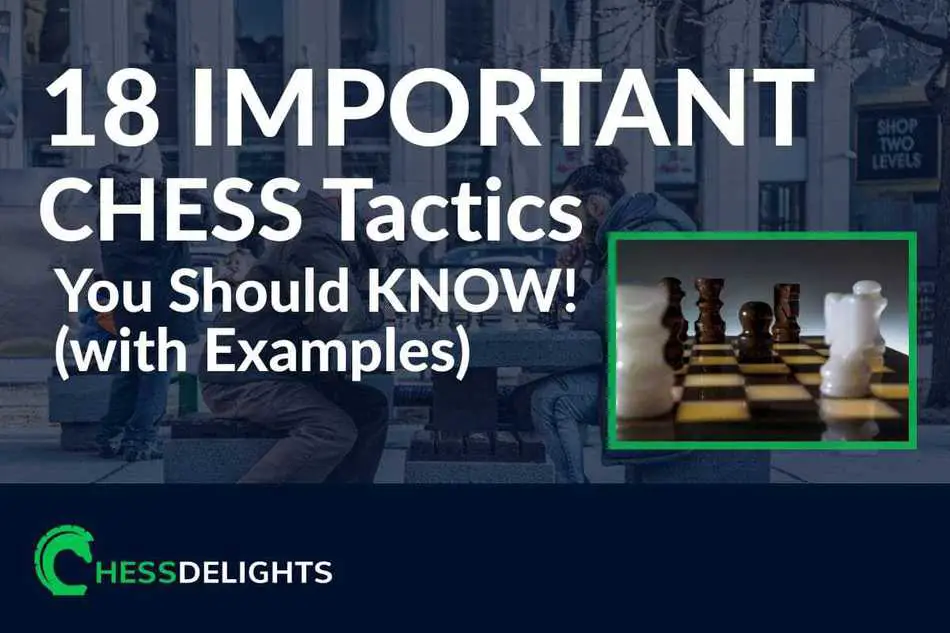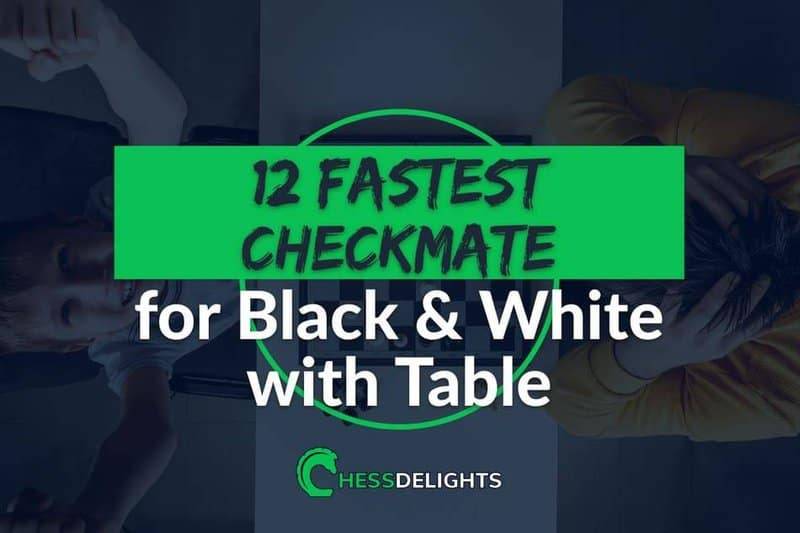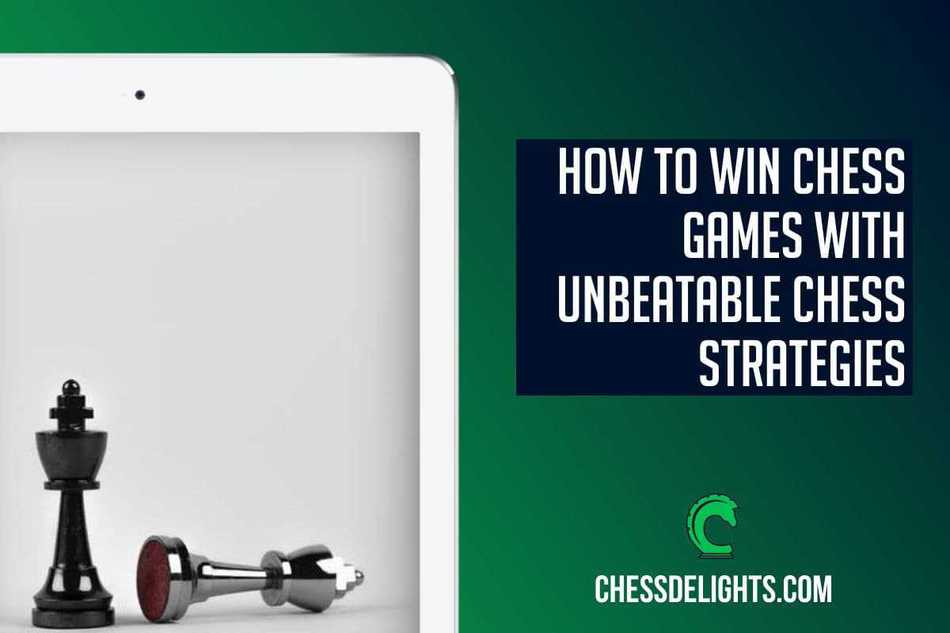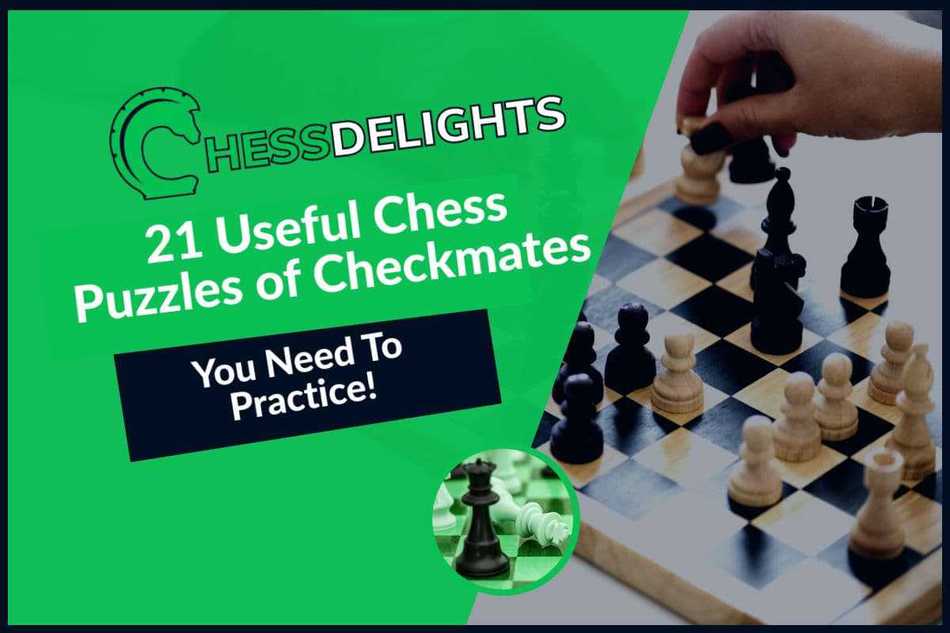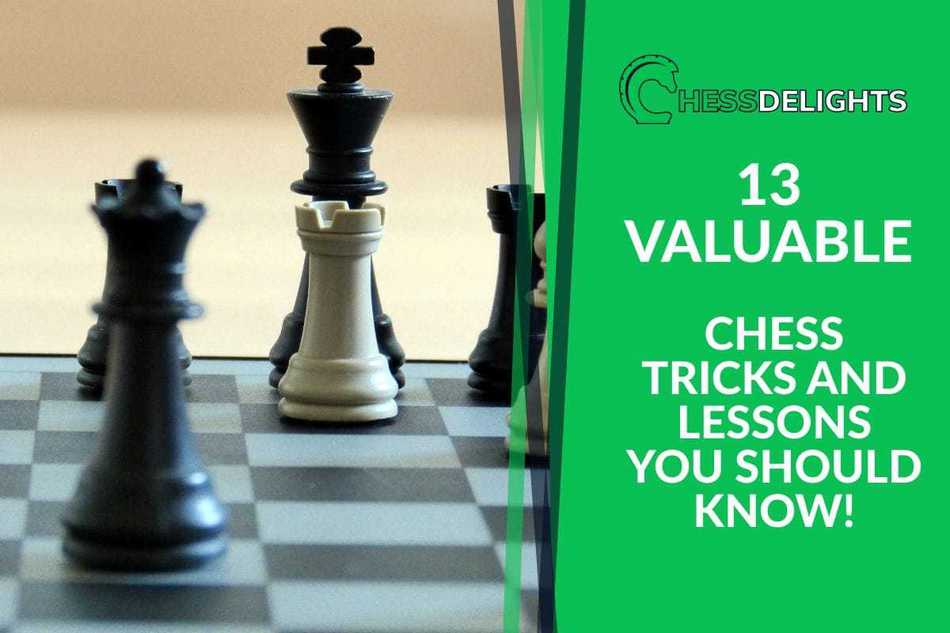Have you ever wondered if chess tactics can help improve your game? Or even improve your chess opening?
When I started re-learning chess and started playing chess online…Oh, man, it was terrible! I was losing five chess games in a row, and I have an inferior play.
So, I tried learning chess openings again and then tried implementing tactics, I started winning back I mean winning (not by luck)… 🙂 But I understood that it's the tactics that I previously learned that helped me win more chess games compared before I did not know any of the tactics below.
That is why I wanted to share these 18 chess tactics with you to at least help you win more competitive chess games.
Table of Contents
Chess Tactics Names and Brief Explanation
1. Back-Rank Checkmate
You can win a chess game by Queen, and Rook to attack the Back-Rank of your opponent. It is the last raw of each opposite side of the board, for White, it is the Raw 1, and for Black, it is the Raw 8.
A back-rank checkmate can only be executed by your Queen or a Rook.
2. Chess Clearance
You have to be vigilant in looking for a useful move or powerful chess tactic to gain material or improve your position.
Chess Clearance or clearance sacrifice is a chess tactic that is used to acquire a square occupied by your chess piece.
An effective way to acquire that clearance is to make a move that will perform a check or will force your opponent to move without losing the purpose of the clearance.
3. Chess Forks (Double Attack)
You can see this most common chess tactic almost every game and sometimes being overlooked and missed by chess players.
Chess Forks or Double Attack most likely will help you gain a material while your opponent saves the other chess piece they think is more valuable. Nonetheless, in most cases, you have a material advantage when you can spot this chess tactic in your game.
Note: Knight is the most dangerous in forking because knight can be very tricky, and I experience being a victim of this chess tactic with Knight Forks.
4. Chess Pins
Ideally, you can stop a chess piece from moving if you applied this chess tactic called Pin or Pinning.
When you pin an opponent's chess piece by its King that is called an Absolute Pin because you cannot legally move that chess piece to expose the King.
But, when you pin a chess piece by another chess piece besides its King, then that is called a Relative Pin because you can legally move the chess piece even if you expose the other chess piece behind it.
5. Chess Skewers
You can use this tactic to gain material advantage as well, just like a chess pin. But with a different setup…
Skewer chess tactic can happen with chess pieces on the same file or raw in the chess board just like a pin, but the more valuable chess piece is directly attacked.
A good example is the King (of course its the most valuable chess piece on the board), and your opponent has no choice but to move it away from the attack and to expose the chess piece behind it.
6. Deflection
You can use this tactic to remove an opponent's protection and capture a chess piece to gain a material advantage, or you can apply this chess tactic to checkmate your opponent by eliminating defenders.
To be effective, you need to know how many defenders protecting the square or the chess piece you want to deflect. If you are sure that you can apply this Deflection chess tactic then go for it.
7. Discovered Attack
You can apply a Discovered Attack by having your pieces align together in raw or a file…
And then you make a move to reveal the other chess piece behind to attack your opponent's chess piece that is in front of the raw or file your pieces are in.
This is a very effective chess tactic to gain material, and this tactic works great if you are attacking your opponent's King with this tactic otherwise called Discovered Check.
8. Double Check
You can use this chess tactic the Double Check to force the King to move. This type of check, unlike the other checks, you cannot block this type of check…
When you apply a Double Check to your opponent, the only legal move is to move the King. This works well with a Discovered Check.
9. Interference
This type of chess tactic tries to make an advance move or even try to win a chess piece.
If you know, you can attack a chess piece without any resistance, and the only chess piece that is stopping you is your chess piece…
Now, the only thing you need to do is to use the Interference chess tactic; you will place your chess piece in harm's way to be able to advance or achieve your purpose.
10. Perpetual Checks
This is a chess tactic where your opponent does not have any other option to avoid the checks.
Perpetual checks are used when you know that your opponent has an advantage and more likely to win the game.
You can use this tactic to avoid losing but force a draw, it is a legal move, and if your opponent does not agree, then your opponent should have prevented this in the first place.
11. Smothered Checkmate
You can only use and maybe see this type of checkmate when its chess pieces surround your opponent's King…
Smothered Checkmate is an exciting way to end a game, it needs precision and skill to execute this type of checkmate, and Knight is mostly used with this type of checkmate.
Kings get into this trouble when you unintentionally trap the King with your pieces, so be careful getting smothered checkmate.
12. Stalemate
You can attempt to get a draw by this chess tactic only if you think it's necessary to do so…
When you are losing, and you found a way to use this chess tactic, then you did not lose a point if playing in competitive chess. Instead, you and your opponent get 1/2 points each.
With the Stalemate tactic, if you do have the opportunity to end the game with a stalemate, you have to make sure that all your pieces can no longer move except for the King…
But…
You cannot legally do so, if that happens, then you have successfully made your losing game (assuming) into a draw.
13. Trapping Chess Pieces
You can use this chess tactic to guard specific squares that your opponent's particular chess piece like a Knight can occupy.
When you can do that usually with any pieces, you can trap another chess piece. Trapping Chess Pieces is a fantastic chess tactic to gain material advantage.
14. Unprotected Chess Piece
You have to be aware of your opponent's unprotected chess pieces and especially your chess pieces…
You will notice this quickly with isolated pawns mainly, and sometimes more than one pawn is unprotected.
This is an important chess tactic not only to gain a material advantage but also to avoid getting yourself losing chess pieces unnecessarily.
15. Windmill
You can use this chess tactic when you have your opponent's King exposed in the board.
Always a right combination to use with a Windmill chess tactic is a Bishop and Rook, depending on the board setup.
When you are down material, and you saw the opportunity to do a Windmill against your opponent, then you can gain a material advantage if successful…
Windmill checks and creates a Discovered Check at the same time, which you can use to capture opponent's chess piece or checkmate is also possible.
16. X-ray
This is used to attack a chess piece indirectly like disregarding the chess piece in front of one line like, for example in a diagonal, vertical or horizontal.
When you say X-ray, you have a chess piece that you want to capture, but there is another chess in front of it…
So, what you are trying to capture is not the front chess piece but the chess piece behind it.
Note: X-ray tactic is precisely synonymous to chess skewers.
17. Zugzwang
A beneficial but simple chess tactic is the Zugzwang; this forces your opponent to make a move, which is a horrible move.
Your opponent would lose an advantage if you were able to pull off this tactic.
Eventually, your opponent should already feel obliged to resign after you make a move that causes a Zugzwang.
18. Zwischenzug
You play this tactic only if you are sure that you can still go back and make the move that you are supposed to move.
Zwischenzug or “in-between” move is a tactic where you hold a move that you are supposedly expected to move first, but instead, you play an “in-between” move but doesn't necessarily make you lose the opportunity to move the first intended move.
This is very tactical and powerful since you can use this to gain material advantage or improve your position.
Examples of Chess Tactics in action
1. Chess Tactics for Ruy Lopez Opening (White)
Double Attack: White Queen Attacks
If you want to gain a material advantage and at the same time threaten your opponent with a checkmate, then you should take a look at a Double Attack by the White Queen in Ruy Lopez.
The White Queen is attacking the Rook and threatening to capture the weakest pawn in the Kingside for a checkmate.
This position can occur during several exchanges, which you need to be very careful with. Follow the chess tactic with the image and chess notation below.
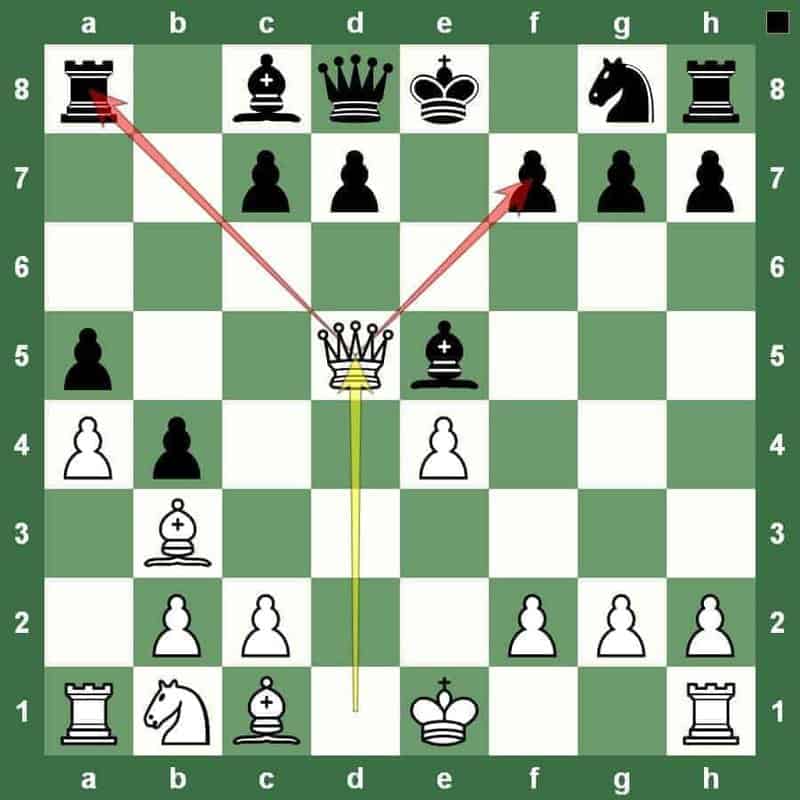
1. e4 e5 2. ♘f3 ♘c6 3. ♗b5 a6 4. ♗a4 b5 5. ♗b3 a5 6. a4 b4 7. d4 ♗d6 8. dxe5 ♘xe5 9. ♘xe5 ♗xe5 10. ♕d5
Chess Fork: White Knights Attack
When playing Ruy Lopez, your Knights can be very lethal and can apply powerful attacks to your opponent.
They say that the most dangerous Chess Forks are of the Knights. If you want to gain material advantage and apply Knight Forks to your opponent on the Kingside and Queenside…
Then check out this Ruy Lopez simple chess tactic you can learn today. Follow the chess tactics with the image and chess notations below.
First the Knight Fork Kingside attack
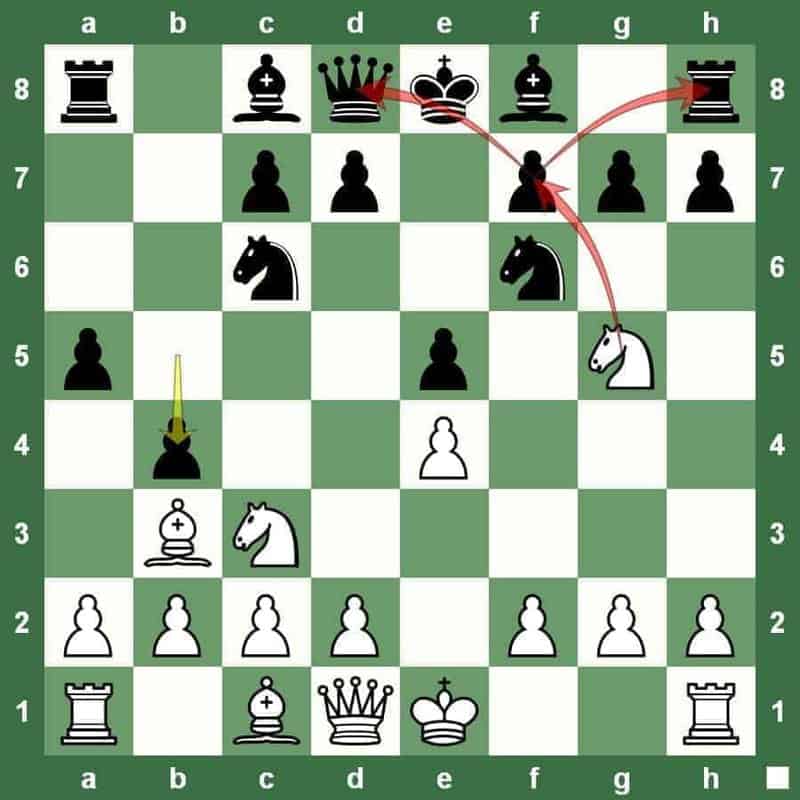
1. e4 e5 2. ♘f3 ♘c6 3. ♗b5 a6 4. ♗a4 b5 5. ♗b3 ♘f6 6. ♘c3 a5 7. ♘g5 b4
Second the Knight Fork Queenside attack
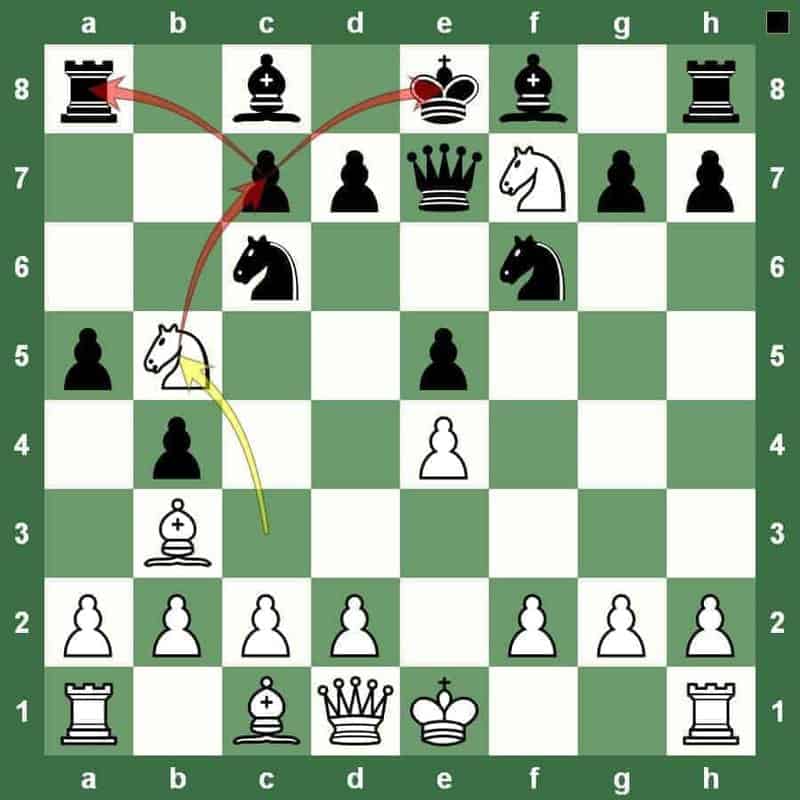
1. e4 e5 2. ♘f3 ♘c6 3. ♗b5 a6 4. ♗a4 b5 5. ♗b3 ♘f6 6. ♘c3 a5 7. ♘g5 b4 8. ♘xf7 ♕e7 9. ♘b5
Chess Tactics for Ruy Lopez Opening (Black)
Smothered Checkmate: Black Knight Checkmate
When you are playing with a Ruy Lopez Opening, you need to be careful with tactics and traps that can occur.
A Black opponent who is familiar with Ruy Lopez Opening can get you in a lot of trouble. So, here are some tactics that Black can play that you need to see.
A Smothered Checkmate by Black Knight can happen when playing Ruy Lopez Opening.
You will know when your opponent will attempt this tactic when the Black Knight has moved to Knight g4 after you have done castling on the Kingside.
Follow the chess tactic with the image and chess notation below.

1. e4 e5 2. ♘f3 ♘c6 3. ♗b5 ♘f6 4. O-O ♘g4 5. ♖e1 ♗c5 6. d4 ♘xd4 7. ♘xd4 ♕h4 8. ♘f3 ♕xf2+ 9. ♔h1 ♕g1+ 10. ♖xg1 ♘f2#
Trapping Chess Pieces: Pawn Attacks
Be aware of chess exchanges when playing with a Ruy Lopez Opening, you can fall for several chess traps and tactics.
One of them will be Trapping your chess piece like the White Squared Bishop, which could be your most important Bishop in the game.
The position occurs with the white squared Bishop retreating from Pawn attacks until the position ends up with the white squared Bishop trapped in the b3 square.
Follow the chess tactic with the image and chess notation below.
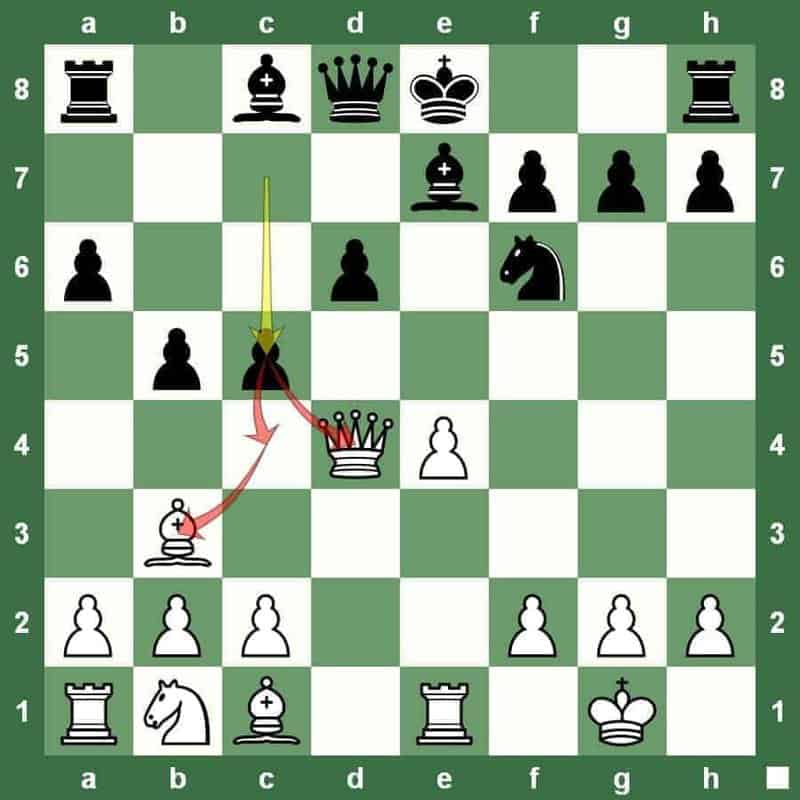
1. e4 e5 2. ♘f3 ♘c6 3. ♗b5 a6 4. ♗a4 ♘f6 5. d4 exd4 6. O-O ♗e7 7. ♖e1 b5 8. ♗b3 d6 9. ♘xd4 ♘xd4 10. ♕xd4 c5
2. Chess Tactics for Italian Game Opening (White)
Double Attack: Pawn Attacks
Italian Game can have a decisive attack when your opponent is not familiar with this opening.
This type of opening is more focused on the development of chess pieces, and you will notice that the game can be very slow at first but can result in a lot of surprise attacks.
One of the moves you should be aware of is a Double Attack by Pawn. A silent move if not noticed, and can lead to Black losing material in a matter of seconds.
Follow the chess tactic with the image and chess notation below.

1. e4 e5 2. ♘f3 ♘c6 3. ♗c4 ♗c5 4. d3 ♘f6 5. ♘c3 d6 6. ♗g5 h6 7. ♗xf6 ♕xf6 8. ♘d5 ♕d8 9. c3 ♗e6 10. d4 ♗b6 11. ♘xb6 axb6 12. d5
Trapping Chess Pieces: Pawn Attacks
Followed by the sequence of moves or exchanges from above… The White can gain a material advantage by Trapping Chess Piece with the Pawn; in this case, the Black Knight will have no other safe squares to go.
You will see this chess tactic in the Italian Game when the Black tries to counter-attack the white squared Bishop.
By doing that, Black did not see the trap by white moving forward its pawn attacking the black knight.
Follow the chess tactic with the image and chess notation below.
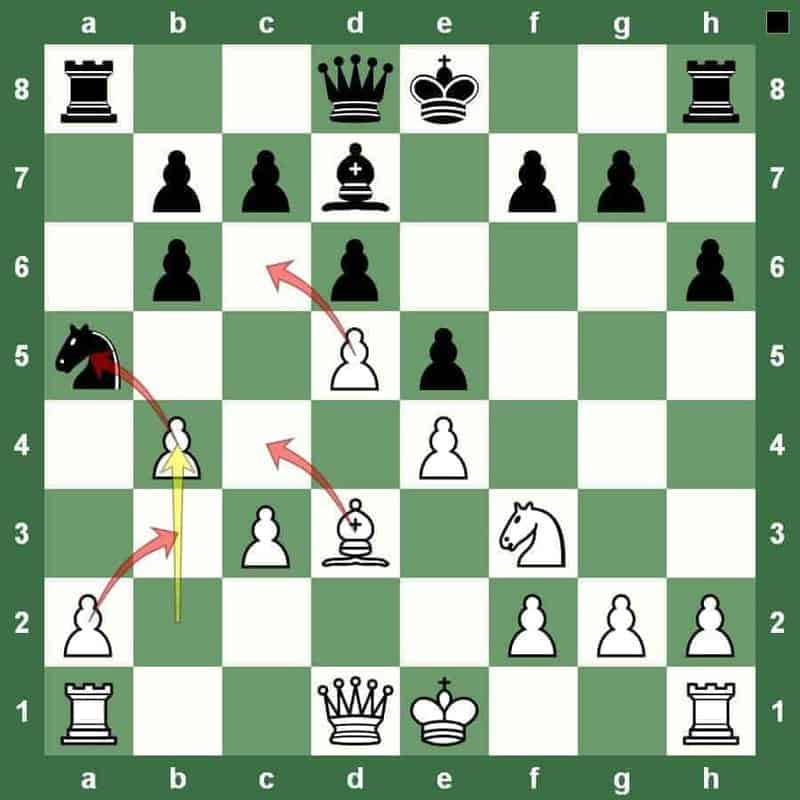
1. e4 e5 2. ♘f3 ♘c6 3. ♗c4 ♗c5 4. d3 ♘f6 5. ♘c3 d6 6. ♗g5 h6 7. ♗xf6 ♕xf6 8. ♘d5 ♕d8 9. c3 ♗e6 10. d4 ♗b6 11. ♘xb6 axb6 12. d5 ♘a5 13. ♗d3 ♗d7 14. b4
Chess Tactics for Italian Game Opening (Black)
Zugzwang and Zwischenzug: Bishop Check and Sacrifice
There are a lot of excellent and tricky chess moves for an Italian Game Opening… One of them is the Fried Liver Attack. This type of move will set the White Knight to threaten a Fork on Black's Kingside.
But…
Black can do a Zwischenzug and a Zugzwang with its Black Squared Bishop. Since the Knight Fork is already there attacking your Black Queen and Black Rook and you do need to save the Queen (because it is the most powerful chess piece), instead of moving the Queen immediately we do a Zwischenzug or an “in-between” move.
You capture the weakest pawn on white's Kingside, and at the same time, you created a Zugzwang forcing the white King to move which will remove its ability to castle later on.
Follow the chess tactic with the image and chess notation below.

1. e4 e5 2. ♘f3 ♘c6 3. ♗c4 ♘f6 4. ♘g5 ♗c5 5. ♘xf7 ♗xf2+
Deflection: Knight Check
You can follow through with a White Queen capture using Deflection tactic in the Italian Game Opening.
The move happened when your Black Queen was able to capture the Rook on White's Kingside.
A sacrifice by the Black Knight capturing Pawn on g3. This will expose the Rook, and thus, you will be able to attack the Kingside quickly.
This move, of course, is the ideal move to show the Deflection that can happen using your Black Knight.
Black Knight will check the King, forcing the King to leave the square, and now you will be able to capture the White Queen without exchanging your Black Queen.
Follow the chess tactic with the image and chess notation below.
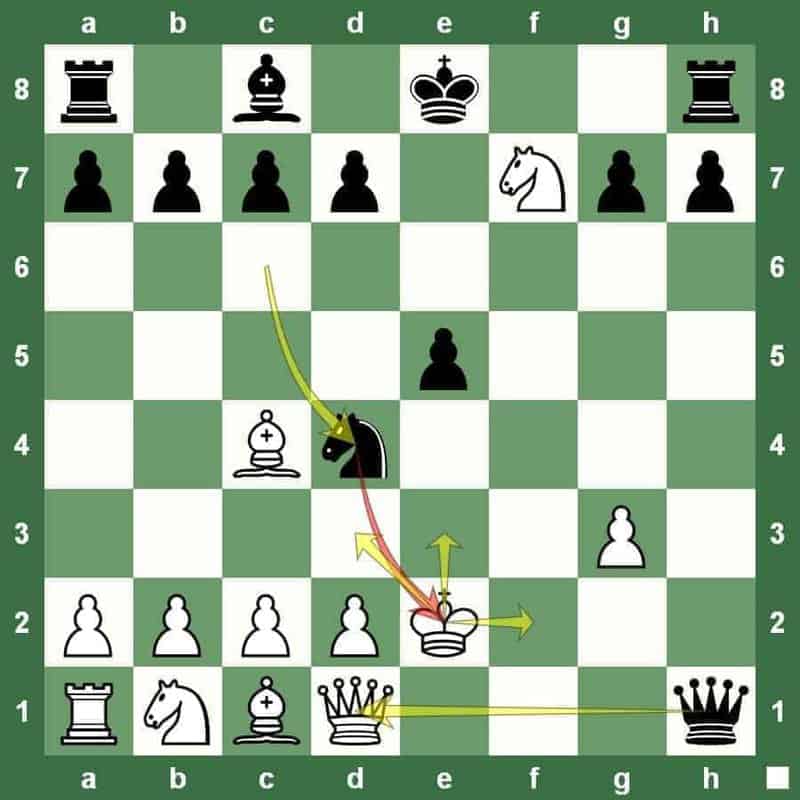
1. e4 e5 2. ♘f3 ♘c6 3. ♗c4 ♘f6 4. ♘g5 ♗c5 5. ♘xf7 ♗xf2+ 6. ♔xf2 ♘xe4+ 7. ♔e1 ♕h4+ 8. g3 ♘xg3 9. hxg3 ♕xh1+ 10. ♔e2 ♘d4+
3. Chess Tactics for Queen's Gambit Opening (White)
Interference: Rook Attacks
An excellent example of Interference would be in Queen's Gambit Accepted line… The main idea would be to let your Black opponent hold on to the captured chess piece by protecting it with the Pawn.
That will set the Interference chess tactic of the Rook. The Rook would want to get into the action by offering its “a4 pawn” to Black's “b5 pawn”, this will remove the interference in the “a file” and making a half-open file that will help to achieve the Rook's goal.
Follow the chess tactic with the image and chess notation below.
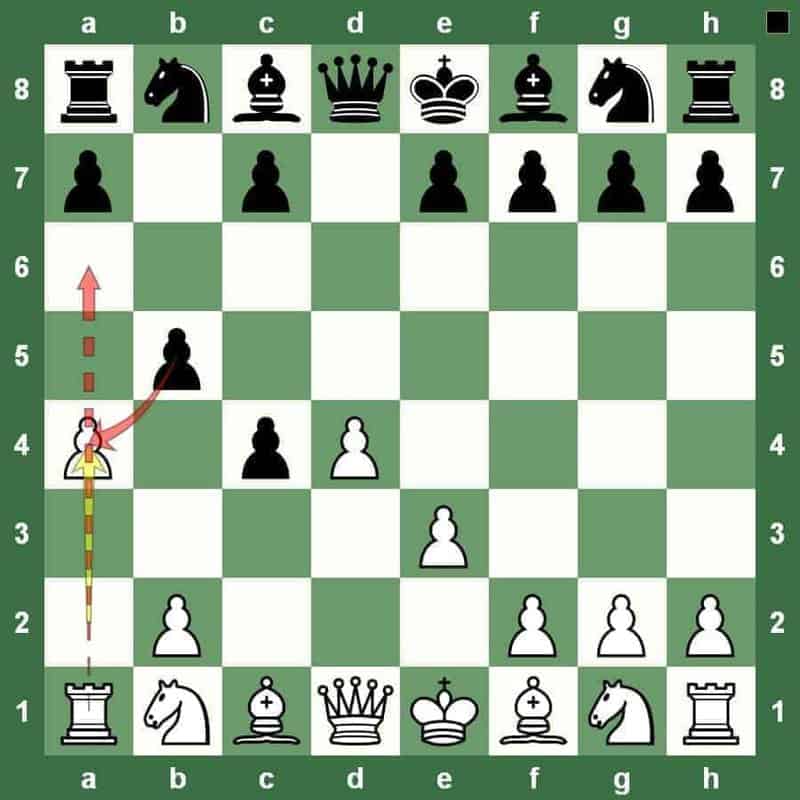
1. d4 d5 2. c4 dxc4 3. e3 b5 4. a4
Unprotected Chess Piece: Queen Attacks
This chess tactic example of Unprotected Chess Piece can also be considered a Zugzwang… With the Queen's Gambit Accepted we can exploit materials of Black and be able to attack and force the White to sacrifice it chess pieces because of an Unprotected Chess Piece, in this case, the Rook.
It can still defend the Rook with a Zugzwang or oblige your opponent to make a losing move.
This chess tactic will be very devastating for Black, and it leaves black with underdeveloped chess pieces and a weak Queenside.
Follow the chess tactic with the image and chess notation below.

1. d4 d5 2. c4 dxc4 3. e3 b5 4. a4 c6 5. axb5 cxb5 6. ♕f3
Chess Tactics for Queen's Gambit Opening (Black)
Chess Pin: Queen Pinning
A calculated move will make this chess tactic work, you need to be very careful, and you should make sure that your opponent has no way of adding another minor chess piece in front of its King…
Otherwise, the Pinning or Absolute Pin will not be very useful for you.
The purpose is to make your opponent's chess piece remain on the same position until it can legally move, while you build a better positioning or much better plan of attack as the next chess tactic of discovered attack.
Follow the chess tactic with the image and chess notation below.
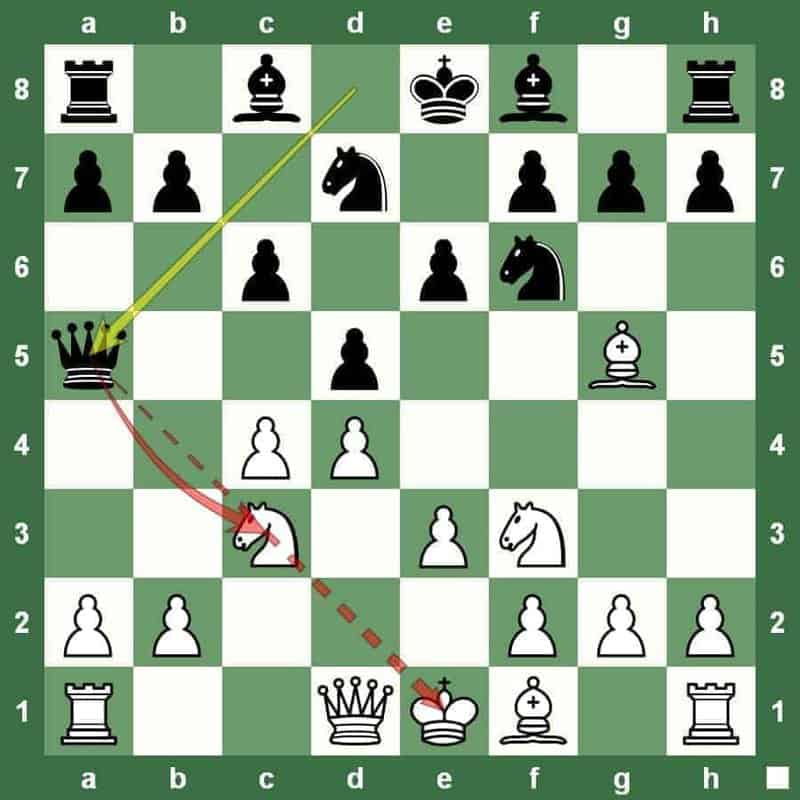
1. d4 d5 2. c4 e6 3. ♘c3 ♘f6 4. ♗g5 ♘bd7 5. ♘f3 c6 6. e3 ♕a5
Discovered Attack: Pawn Captures Pawn
This chess tactic can happen with Queen's Gambit Declined, and a sequence of a move like Black Queen pinning the White Knight will be required…
Because these positions align the Black Queen with the White's Bishop on the same rank. The Discovered Attack will be successful if only the black squared Bishop of white will try to attack your Knight on e4.
Only then the attempt for this chess tactic can work to gain material advantage.
Follow the chess tactic with the image and chess notation below.
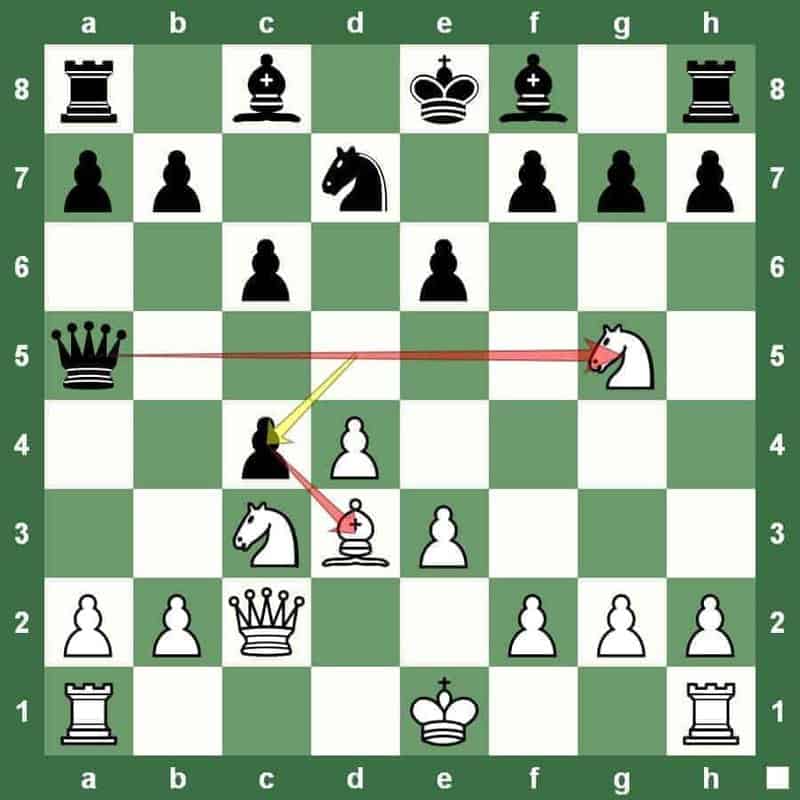
1. d4 d5 2. c4 e6 3. ♘c3 ♘f6 4. ♗g5 ♘bd7 5. ♘f3 c6 6. e3 ♕a5 7. ♕c2 ♘e4 8. ♗d3 ♘xg5 9. ♘xg5 dxc4
4. Chess Tactics for Sicilian Defense Opening (White)
Chess Clearance: Queen Checkmate
A very interesting checkmate from White to Black's Sicilian Defense…
If your opponent is familiar with some main lines of a Sicilian Defense game, then your opponent may be surprised with a chess move that sacrifices a Bishop to make this chess tactic of Chess Clearance happen.
This chess tactic will need some other surprising sacrifices like your Knights, for instance.
And with the Clearance Chess tactic, your opponent will not know what your real plan is.
Follow the chess tactic with the image and chess notation below.

1. e4 c5 2. ♘f3 d6 3. d4 cxd4 4. ♘xd4 ♘f6 5. ♘c3 a6 6. ♗g5 e6 7. f4 ♘bd7 8. ♗c4 b5 9. ♗xe6 fxe6 10. ♘xe6 ♕b6 11. ♘d5 ♘xd5 12. ♕xd5 ♗b7 13. ♘c7+
Back-Rank Checkmate: Queen Checkmate
Another sequence of move for White that will lead Black's Sicilian Defense is the chess tactic Back-Rank Checkmate.
It is also a Discovered Attack by the White Queen to the Black Queen, with the help of the Knight's check at the same time Double attack.
The Back-Rank Checkmate happens when the discovered attack has been executed properly, and then instead of pawn taking your Knight, it is the Black's white-squared Bishop.Note:
Keep in mind that whatever the Black uses to capture the Knight, it will still be a terrible situation for Black. Eventually, it is going to be over soon for Black.
Follow the chess tactic with the image and chess notation below.
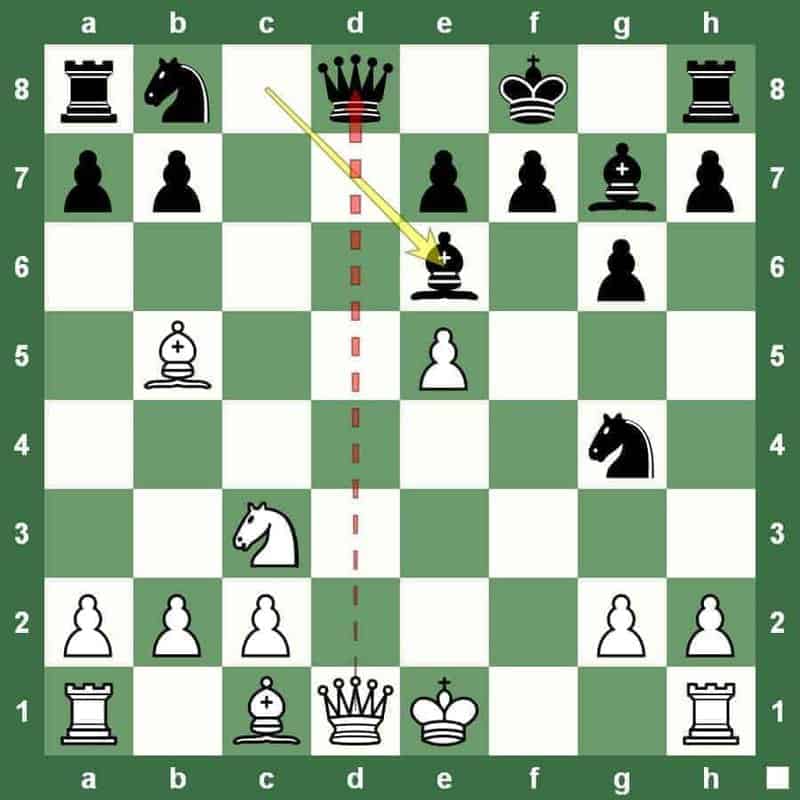
1. e4 c5 2. ♘f3 d6 3. d4 cxd4 4. ♘xd4 ♘f6 5. ♘c3 g6 6. f4 ♗g7 7. e5 dxe5 8. fxe5 ♘g4 9. ♗b5+ ♔f8 10. ♘e6+ ♗xe6
Chess Tactics for Sicilian Defense Opening (Black)
Chess Skewer: Rook Attacks
I saw an excellent chess tactic that can attack your opponent's Queenside and then apply a chess skewer; you can have success with this if your opponent overlooked this simple move…
You need to push forward your pawn on your Queenside, and then you will be able to open up your opponent's Queenside.
When you are successful with this move, you can go on and win the game against your opponent.
Follow the chess tactic with the image and chess notation below.
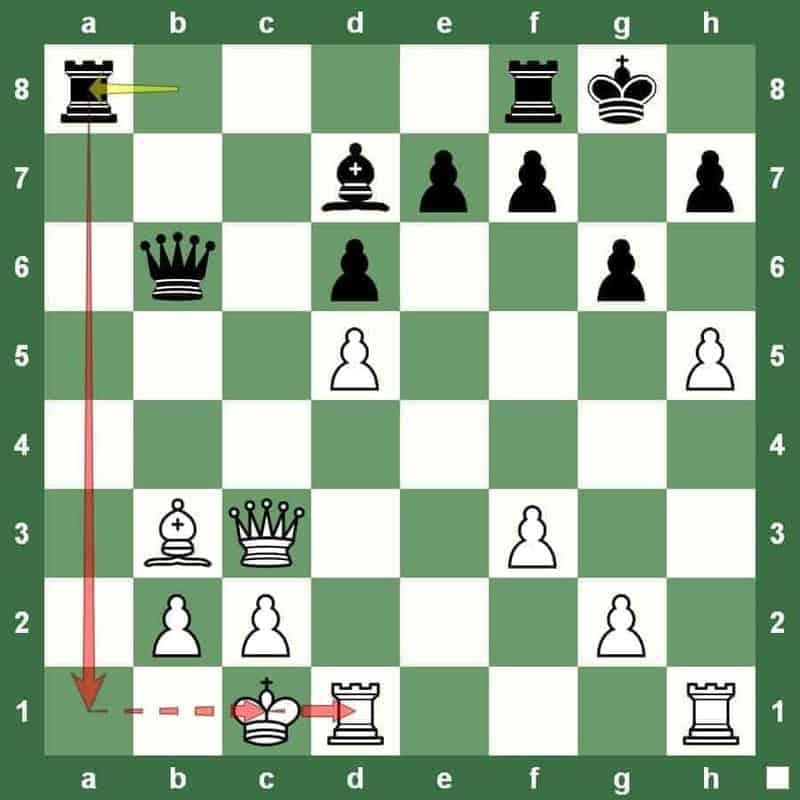
1. e4 c5 2. ♘f3 d6 3. d4 cxd4 4. ♘xd4 ♘f6 5. ♘c3 g6 6. ♗c4 ♗g7 7. f3 O-O 8. ♗e3 ♘c6 9. ♕d2 ♗d7 10. O-O-O ♖c8 11. ♗b3 ♘xd4 12. ♗xd4 b5 13. h4 a5 14. a3 b4 15. axb4 axb4 16. ♘d5 ♘xd5 17. ♗xg7 ♔xg7 18. exd5 ♔g8 19. ♕xb4 ♖b8 20. ♕c3 ♕b6 21. h5 ♖a8
X-ray: Rook Attacks
Several sequences of moves from the Sicilian Defense will lead you to a chess tactic called an X-ray…
Your Rook needs to be in the same file as the King but with chess pieces covering the King.
There is an opportunity to win the game in this way, especially if you have an excellent position for a checkmate. But this checkmate will not happen if you did not see the X-ray chess tactic by your Rook.
Follow the chess tactic with the image and chess notation below.
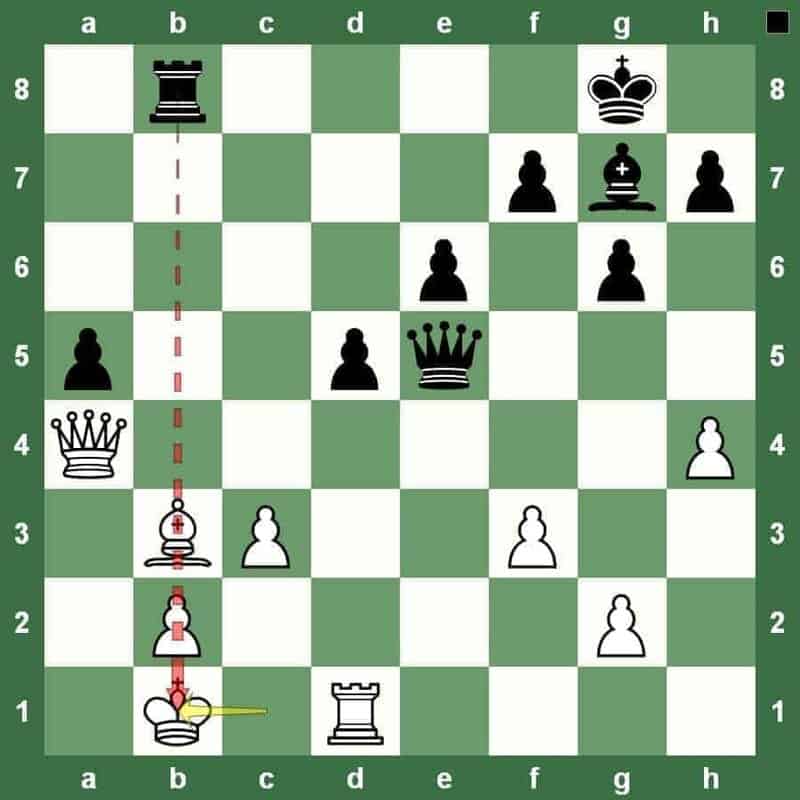
1. e4 c5 2. ♘f3 d6 3. d4 cxd4 4. ♘xd4 ♘f6 5. ♘c3 g6 6. ♗c4 ♗g7 7. f3 O-O 8. ♗e3 ♘c6 9. ♕d2 ♗d7 10. O-O-O ♖c8 11. ♗b3 ♘xd4 12. ♗xd4 b5 13. h4 a5 14. a4 bxa4 15. ♘xa4 ♗xa4 16. ♗xa4 ♖c4 17. ♗b3 ♘xe4 18. ♕e3 ♖xd4 19. ♖xd4 ♘g3 20. ♖dd1 ♘xh1 21. ♖xh1 ♕b8 22. ♕e4 d5 23. ♕a4 ♕e5 24. c3 ♖b8 25. ♖d1 e6 26. ♔b1
5. Chess Tactics for King's Indian Defense (White)
Stalemate: Rook Check
This game below will prove that you can draw a game if you keep on looking for an opportunity… It is better to end with a draw like a Stalemate than getting zero points.
That opportunity came with a double rook and attacked the Black King, and if the King moves out of the way, then the game will shift the advantage to White quickly…
And the game resulted in a Stalemate.
Follow the chess tactic with the image and chess notation below.
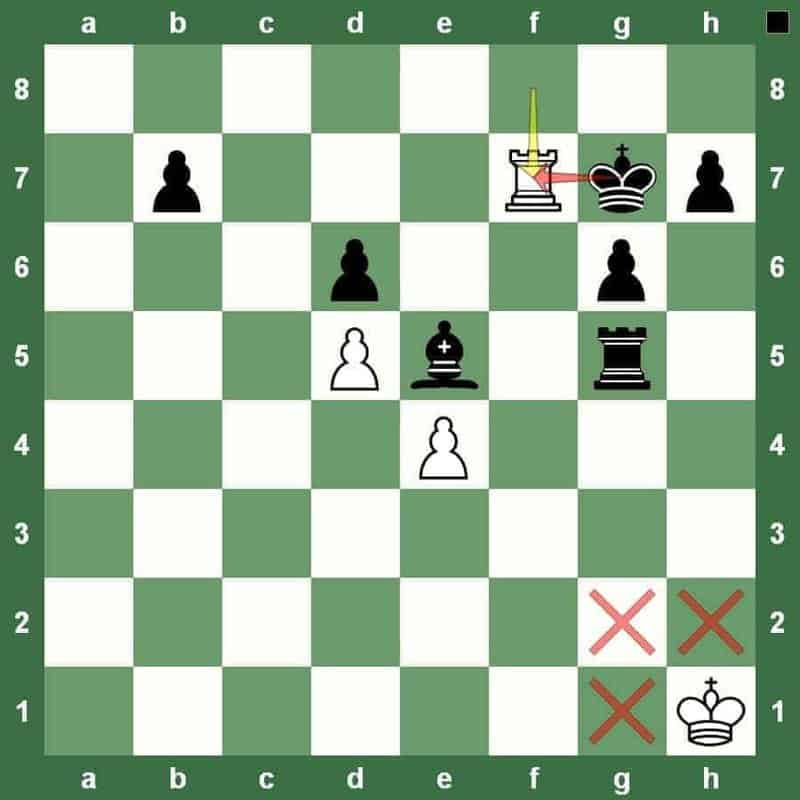
1. d4 ♘f6 2. c4 g6 3. g3 ♗g7 4. ♗g2 O-O 5. ♘c3 d6 6. e4 ♘c6 7. ♘ge2 ♗g4 8. h3 ♗xe2 9. ♘xe2 e5 10. O-O ♖e8 11. d5 ♘d4 12. ♗e3 ♕e7 13. ♘xd4 exd4 14. ♗xd4 ♕f8 15. ♕c2 ♖e7 16. c5 ♖ae8 17. f3 ♘h5 18. ♗f2 f5 19. ♖ad1 fxe4 20. fxe4 ♗e5 21. cxd6 cxd6 22. ♗xa7 ♕h6 23. g4 ♘f4 24. ♖f3 ♖a8 25. ♗e3 ♖xa2 26. g5 ♕xg5 27. ♖df1 ♕xg2+ 28. ♕xg2 ♘xg2 29. ♔xg2 ♖xb2+ 30. ♔g1 ♔g7 31. ♖f8 ♖b3 32. ♗d2 ♖g3+ 33. ♔h1 ♖xh3+ 34. ♔g1 ♖d3 35. ♗c1 ♖c7 36. ♗g5 ♖g3+ 37. ♔h1 ♖xg5 38. ♖1f7+ ♖xf7 39. ♖xf7+
Chess Tactics for King's Indian Defense (Black)
Perpetual Check: Knight Attacks
When you play with a strong chess player, you need to find a way to become a tactical player. One tactic in chess you need to utilize is the Perpetual check. In the game below, white won the exchanges having a Rook and a Queen, while Black has a Queen and a Knight.
The danger with this setup is Black King is exposed and can easily be mated by White. So, the Black chose to apply a perpetual check instead of losing points.
Follow the chess tactic with the image and chess notation below.
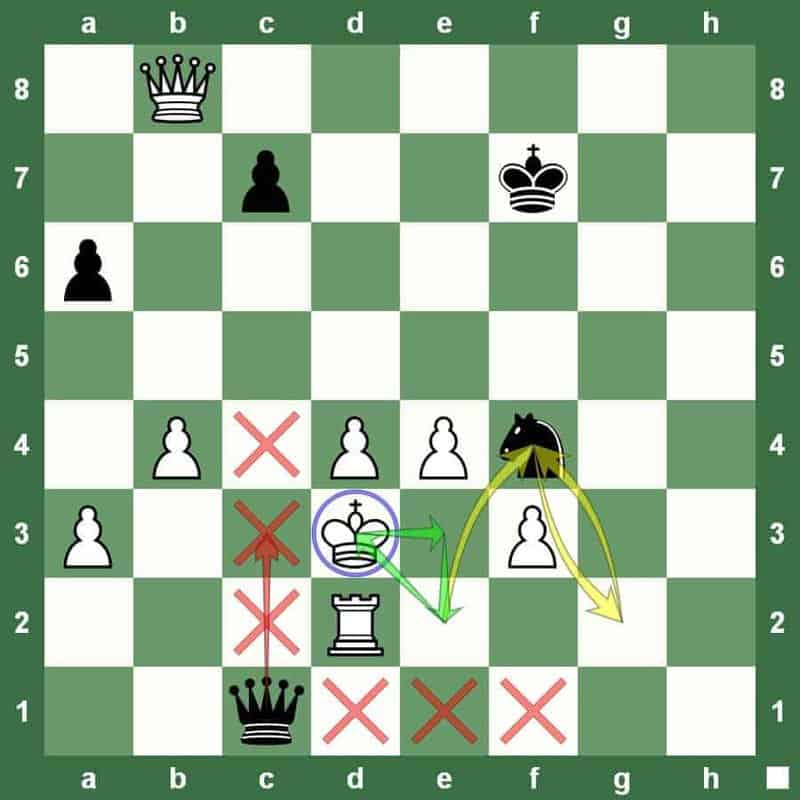
1. d4 ♘f6 2. c4 g6 3. ♘c3 ♗g7 4. e4 d6 5. f3 O-O 6. ♗e3 ♘c6 7. ♕d2 a6 8. ♘ge2 ♖b8 9. h4 h5 10. ♗h6 ♗xh6 11. ♕xh6 b5 12. g4 e5 13. gxh5 ♘xh5 14. O-O-O bxc4 15. ♖g1 ♕xh4 16. ♘d5 c3 17. ♖g5 c2 18. ♔xc2 ♘b4+ 19. ♘xb4 ♖xb4 20. a3 ♖b6 21. ♘g3 ♗d7 22. b4 ♖fb8 23. ♖xg6+ fxg6 24. ♗c4+ d5 25. ♗xd5+ ♗e6 26. ♕xg6+ ♔f8 27. ♗xe6 ♖xe6 28. ♕xe6 ♘xg3 29. ♕xe5 ♘e2 30. ♖d2 ♕e1 31. ♕h8+ ♔f7 32. ♕xb8 ♕c1+ 33. ♔d3 ♘f4+
6. Chess Tactic for Caro-Kann Defense
Double Check: Rook and Bishop Check
A Double Check is another powerful chess tactic that you can experience in a chess game. For this example, we are going to look at a Double Check initiated by White.
The tactic happened with a back-rank check of Queen, which is also a sacrifice. Once initiated, the Double Check was ready to finish the game.
Follow the chess tactic with the image and chess notation below.

1. e4 c6 2. d4 d5 3. ♘c3 dxe4 4. ♘xe4 ♘f6 5. ♕d3 e5 6. dxe5 ♕a5+ 7. ♗d2 ♕xe5 8. O-O-O ♘xe4 9. ♕d8+ ♔xd8 10. ♗g5+
7. Unknown Chess Opening
Windmill: Rook and Bishop Check
A compelling tactic you can use to either equalize a material, checkmate your opponent or even for a draw is the Windmill chess tactic.
I never really knew about this technique, but I do remember using this before… 🙂 I saw this one game where this tactic was used and sorry the Chess Opening can either be Queen's Gambit or a King's Indian Defense not sure.
But do check out the Windmill example below.
Follow the chess tactic with the image and chess notation below.

1. ♘f3 g6 2. c4 ♗g7 3. d4 d6 4. ♘c3 ♘d7 5. e4 e6 6. ♗e2 b6 7. O-O ♗b7 8. ♗e3 ♘e7 9. ♕c2 h6 10. ♖ad1 O-O 11. d5 e5 12. ♕c1 ♔h7 13. g3 f5 14. exf5 ♘xf5 15. ♗d3 ♗c8 16. ♔g2 ♘f6 17. ♘e4 ♘h5 18. ♗d2 ♗d7 19. ♔h1 ♘e7 20. ♘h4 ♗h3 21. ♖g1 ♗d7 22. ♗e3 ♕e8 23. ♖de1 ♕f7 24. ♕c2 ♔h8 25. ♘d2 ♘f5 26. ♘xf5 gxf5 27. g4 e4 28. gxh5 f4 29. ♖xg7 ♕xg7 30. ♖g1 ♕e5 31. ♘f3 exd3 32. ♘xe5 dxc2 33. ♗d4 dxe5 34. ♗xe5+ ♔h7 35. ♖g7+ ♔h8 36. ♖g6+ ♔h7
Wrapping Up
I believe these chess tactics can improve your game, although not 100% but you can understand the techniques and overpowering tactics to help you with your chess game. The chess opening examples with chess tactics can help you to think like a real tactical chess player.
I advise you to follow the chess notation below the images and follow through the movements. You need to analyze the game and the particular tactic written on the chess opening.
This will guide you on what tactic are you expecting to implement.
Again if you do have any other ideas about this topic, please leave your comment below.
Have fun learning chess! 🙂

